Les Grands Moulins de Pantin: from the factory in the city to the tertiary complex
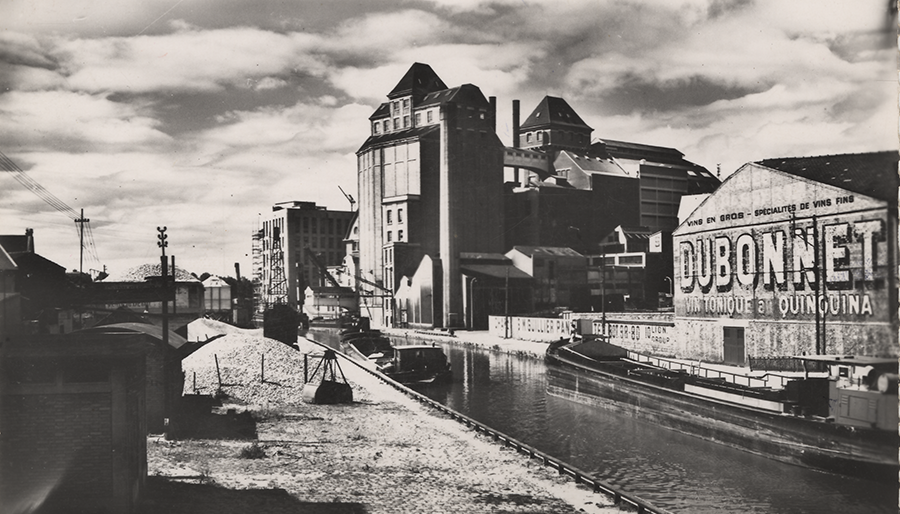
At the gateway to the capital, two major flour mills were built in Pantin between 1880 and 2001. The Grands Moulins de Pantin, squeezed between the Canal de l’Ourcq and the Paris-Strasbourg railway line, transformed French wheat into flour for 121 years, as the milling industry underwent technical, economic and cultural changes. In 2003, as flour exports to developing countries fell, the factory, a landmark in the town’s history, came to a definitive halt.
With the arrival of BNP Paribas on the scene in 2006 and the launch of work to convert the site into an office complex, the history of this landmark of north-eastern Paris’ industrial heritage has taken a new turn. A look back at more than a century of transformations.
The Abel-Stanislas Leblanc Mill at the heart of an industrial area under construction
Crossed by the ancient Roman road to Germany, the Pantin area was originally known for its market garden and agricultural resources. From the 1840s onwards, Pantin experienced an industrial boom thanks to the densification of its transport network and infrastructure, as well as low land prices. Agricultural land was transformed into an industrial zone, with factories and warehouses springing up all over the place.
In 1846, the Paris-Strasbourg line was inaugurated, serving Pantin station from 1864. The town was now at the heart of a dynamic network of trade and commerce.

At the same time, and at the request of Napoleon III, Haussmann developed the first “Greater Paris” by absorbing the many towns that touched the capital. La Villette, near Pantin, was annexed. The interdependence between Paris and Pantin became even more pronounced with the gradual development of the Ourcq canal.
Against this backdrop and the growing demand for white flour, Abel Stanislas Leblanc, a miller from the Brie region, bought a plot of land on 5 April 1880 to build his mill. Capitalising on his first experience as a mill worker, his contribution to the modernisation of French milling and his acquisition of several mills in Coulommiers and Mouroux, he launched this new business in Pantin.
The first flour mill or the continuous integration of technical innovations
The first flour mill was completed in 1882. Abel Leblanc opted for a grindstone mill rather than a cylinder mill, against a backdrop of competition between these two techniques. At the 1878 Universal Exhibition, the Hungarians extolled the superiority of porcelain cylinders and fluted tempered cast-iron cylinders, which would produce a higher yield of white flour than the millstone solution. The techniques on which the mill was based were perfected: 12 pairs of millstones on the ground floor powered by steam.
The buildings occupied the eastern part of the site, while the western courtyard was reserved for the wagons that brought in the wheat and the horse-drawn carriages that shipped the flour.
In 1886, the mill was fitted with cylinders following a number of joint events. Abel Stanislas Leblanc died. The company recorded poor results, partly due to international competition. Finally, the publication of studies demonstrating the superiority of cylinders also confirmed Abel Leblanc’s successors in this choice.
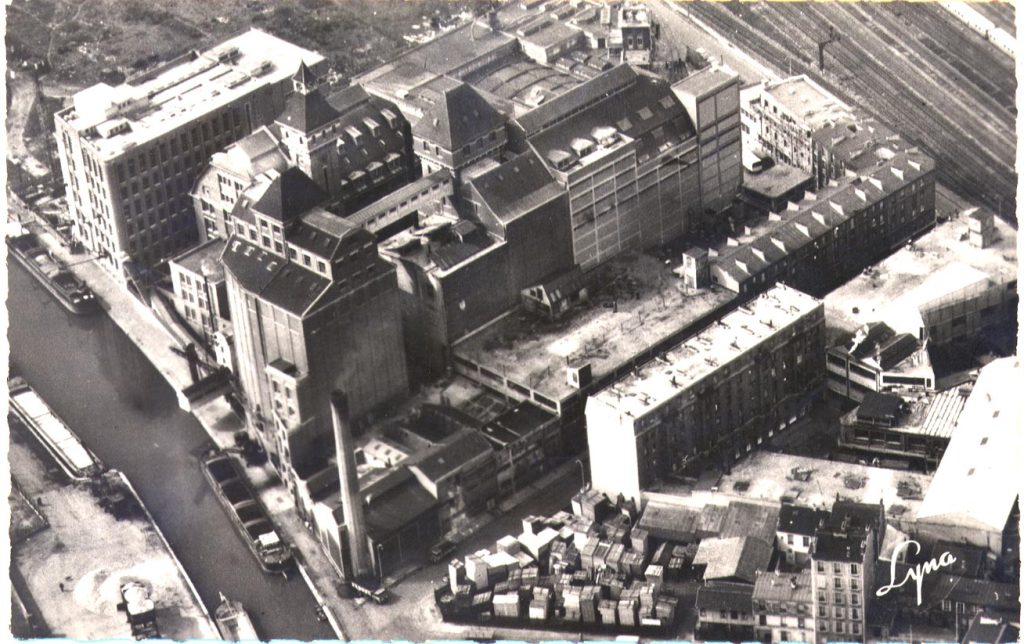
Société des Moulins de Pantin was dissolved on 8 May 1885. The son of the founder, Abel Désiré Leblanc, decided to join forces with the miller Gustave Léopold Duval to create “Les Moulins de Pantin” under private contract. This was an opportunity to install new equipment and infrastructure, such as the main building along the rue de l’embarcadère, which was used as offices and accommodation for one of the partners. For ten years, the first flour mill continually incorporated the technical innovations of the time.
On 23 September 1889, the mill was ravaged by fire, with only the shop saved by the fire brigade.
With extensive insurance cover, the owners rebuilt the site from scratch, increasing production capacity: 11 roller mills on two lines on the ground floor (one mill had 4 rollers), an extra floor for two suction chambers. A large general fan produced a current of air to remove dust and cool the equipment. The mill was designed to crush 450 quintals of wheat a day, with two shifts of four workers working day and night thanks to electric lighting.
In 1894, the 120-horsepower steam engine powering the mill was replaced by a 320-horsepower lean gas engine, a world first. It was a simplex engine designed by the Delamare-Debouteville et Maladin company, which had invented the first motor car with an internal combustion engine back in 1884.
After another change of ownership and the installation of fourteen cylinders, the mill was bequeathed to the town of Coulommiers in 1915.
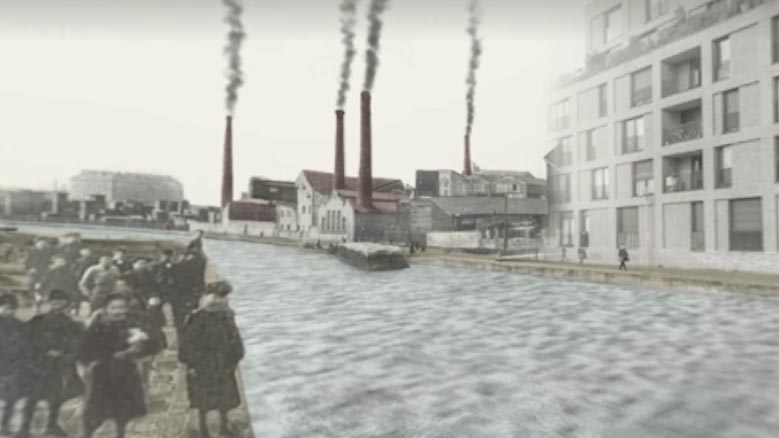
The second flour mill: a cathedral factory inspired by Alsace
In the aftermath of the First World War, the rural exodus continued and French agriculture was short of manpower, leading to an increase in the price of grain at a time when urban demand was growing. This led to concentration in the sector and the creation of milling cartels.
Flour mills were modernised with the use of reinforced concrete and became denser at the same time. To face up to the competition, Grands Moulins de Strasbourg set up a limited company on 18 July 1921 under the name “Grands Moulins de Pantin-Paris” and became the majority shareholder. The aim was to compete with the biggest cartels and build an optimised production facility.
Strasbourg architect Eugène Haug was given the task of translating the new company’s ambitions into an architectural project. In 1923, a new mill was built. It took the form of a block factory inspired by the block houses of the Vosges valleys, bringing together all the functions of family and farm life under the same roof.
The new building features a reinforced concrete (fireproof) frame, blond northern brickwork, a high gambrel roof, two oculi (round windows that illuminate the “useless” part of the mill), sloping dormers and a skylight on the upper part of the roof for ventilation. The whole combines stylistic references with functionality.

On the 6th floor of the mill, under the concrete framework, the vertical circulation of products is ensured from the tip of the mill to the first floor by fir ducts, replaced in the 1970s by metal or PVC ducts. Bucket lifts were used to move products from the bottom to the top.
Between 1924 and 1925, a water tower belfry adorned with clocks was erected 47 metres high. A waiver from the municipality was required to overcome the easements limiting all constructions to a height of 20 metres. Approval was granted because of the usefulness of the clocks to the local population.
The Belfry has a winding staircase and a water tank at the top to supply the fire-fighting system. Of medieval inspiration, it is topped by a square corbelled storey pierced by vertical bays with a pavilion roof covered with rectangular flat tiles and topped by a bell tower. The architect played with colours, using blond brickwork, decorative red and white cement. At this time, the factory employed around 220 workers, most of whom were involved in bagging and shipping flour. A second tower opposite the belfry housed the heads of the bucket lifts that took the grain to the top of the silo.
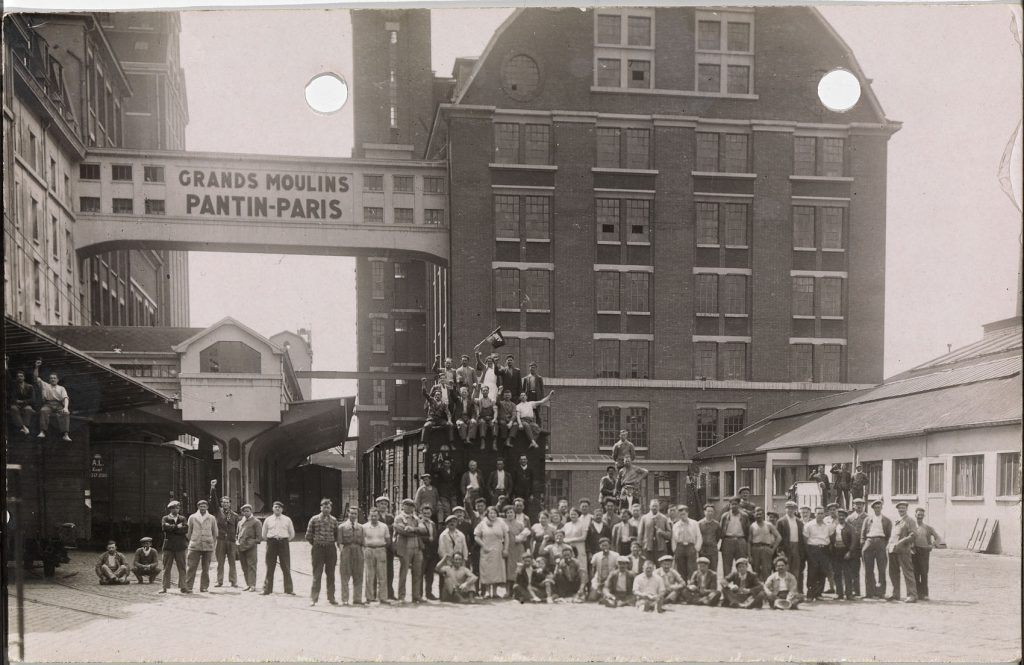
Electricity and densification of the flour mill
Electricity, the key energy of the second industrialisation, was introduced to the mill in the 1920s with the construction of a 2,600 kW power station to the east of the plot, on the site of the old flour mill. There are one or two electric motors on each level of the mill.
The thermal power station symbolises the introduction of electricity into the industrial process of the flour mill, which until then had used steam. Built between 1923 and 1926, it supplies the mill with electricity. A subsidiary of Babcock & Wilcox, which had been operating in La Courneuve since 1898 for the French market, built the double boiler, complete with 1,200-tonne coal silos.
Around 1930, engineers Zublin and Perrière built the Canal silo, a wheat silo with a capacity of 120,000 quintals and a height of 52.70 metres. It is a reinforced concrete building clad in brick, with seven bays of vertical storage topped by a square storey and capped by a hipped roof housing lifts.
Goods traffic was concentrated to the east of the courtyard, so the annex buildings were built to the west from the mid-1920s until 1944.
These were simple sheds near the mill (carpentry workshop, mechanics, general shop, iron and wood shop, garage for repairing lorries, refectory and cooperative kitchen). Everything was then grouped together behind the bakery, which marked the entrance to the site. The bakery included a test mill, a laboratory, a test bakery and, above all, a bakery school, which appears never to have had any pupils (destroyed during the Second World War). The wheat delivered had to be analysed in the laboratory, and the quality of the sample determined the composition of future mixes. The wheat is transformed into flour in a test mill, then taken to the test bakery where the flour is breaded to assess the likely quality of the finished product.
The 1944 fire and the rebuilding of the mill
On the night of 19 to 20 August 1944, a fire broke out. At around 9pm, the Germans blew up a barge full of mines, moored on the Ourcq canal at the foot of the mills, causing several hundred metres of damage. Then, during a battle with the FFI, the Germans responded with a heavy fire of incendiary shells, several of which fell on the large mills. The fire brigade’s response was hampered by the fighting. The fire started in the flour shop and then spread to the mill. A thunderstorm helped the firefighters at 1.20am. They pushed back the danger that had spread to the silos.

Léon Bailly was appointed to manage the reconstruction work. The new flour shop went from 8 to 13 storeys, and the metal floors became fire-resistant reinforced concrete floors capable of supporting a load of 2 tonnes per m2. The bays are very distinctive. One of them protrudes, suggesting the installation of a goods lift. It is a marriage of form and materials with the restored buildings (gambrel and half-hipped roof, skylight). The old power station has been replaced by 500 horsepower engines. It was only slightly damaged by the fire and was still in use until the 1960s, as a support facility.
In 1952, the Grands Moulins de Strasbourg semolina mill was rebuilt within the Pantin factory (crushing mill, durum wheat silos, semolina shop). The mill was made of steel, and the silos and shop of reinforced concrete, all housed in a single factory building with red brick facades.
Over a period of 50 years, the mill tripled its crushing capacity from 4,500 quintals per day in 1950 to 12,000 quintals in 1980. It is the third largest flour mill in France after Paris and Corbeil.
Despite the steady fall in bread consumption in France, which began during the “Trente Glorieuses”, Moulins de Pantin generated 50% of its sales from bakers in and around the capital, thanks to its attractive prices and innovative sales practices. In 1957, the company launched bulk deliveries direct to artisan bakers, as well as assistance with the installation of flour chambers in bakeries. At that time, there were lorries with several cells (one for each customer), and large 250 quintal trucks for industrial customers.
The increase in processing capacity meant that the cleaning section of the mill had to be raised, the equipment had to be renewed and new silos had to be built.
The first was for bulk flour, on the canal side, with bare facades hiding the old flour mill and an issues silo next to the old power station. In the early 1970s, the plant employed up to 500 people. The flour shop was the last to be mechanised.

The workforce has been shrinking rapidly since 1970, as the introduction of bulk products for both flour and issues has reduced the number of pullers and rollers, while the introduction of palletisers distributing bags on conveyor belts has eliminated the coltineurs (coltineurs could carry 100 kilos before labour regulations were introduced, then 50): the modernisation of the equipment has called into question the manufacturing and maintenance workshops, which, like transport, were replaced by subcontractors at the end of the 1980s. The semolina factory was closed for good in 1985 following the closure of the Corbeil pasta factory, which had been weakened by the fall in sales of French pasta in favour of cheaper Italian pasta. The industrial bakery business held up well, but supplies to craft bakers fell. In 1990, they created the Baguépi brand to counter the Banette competitor. But a new period of concentration of flour mills was taking place. The Soufflet group, a major French cereal producer, bought the mills in 1994.
The mill ceased production in 2001, and the site was closed in 2003 in a highly competitive environment. Flour exports to countries in the southern hemisphere were falling steadily, due to the development of local production in those countries.
But the story of these buildings is not over yet. It has taken a new twist with the arrival of BNP Paribas.
A new beginning for The Grands Moulins
The Soufflet Group is approaching the town to facilitate the sale of the Grands Moulins site. The new mayor, Bertrand Kern, wants to convert the buildings for a tertiary activity, while preserving the historic traces. A consultation process was launched, involving the departmental architecture and heritage department and the regional conservation authority for historic monuments. In 2001, the project by Reichen et Robert & Associés, an architectural practice renowned for its exemplary redevelopment of industrial buildings, was chosen for the conversion of the site.
The aim is to highlight the most interesting elements and to construct new buildings of moderate size and volume in order to clear and highlight the skyline formed by the old buildings, while organising the ground plan as a city district.
It is one of the last remaining testimonies to the city’s major industrial activity, and retains a special place in the Parisian imagination.

In 2003, Philippe Zivkovic, Chairman of BNP Paribas Real Estate, agreed to take part in the project. It took two years to launch the refurbishment project: the building permit was issued, with criteria for modern buildings adapted to the 21st century and certified HQE (maximum use of natural light thanks to double-skin windows, new materials, management of waste from the site sorted and evacuated and potentially recycled, etc.). The foundation stone was laid in 2007.
By 2009, the transformation was complete and the challenge of this highly complex project had been met: the mills had become a 50,000 m2 office complex capable of accommodating more than 3,000 employees in extremely comfortable conditions. The 1950s semolina mill, of no architectural interest, was demolished. The reinforced concrete framework, which supports the roof, has been retained to respect the silhouette of the buildings. The cobblestones and rails have been reused to preserve a trace of the past. Glass facades have been incorporated, and the boiler has been restored for display, to create a link between history and progress, and to ensure that each era remains legible.
Discover the experience Grands Moulins de Pantin 360° and travel through time
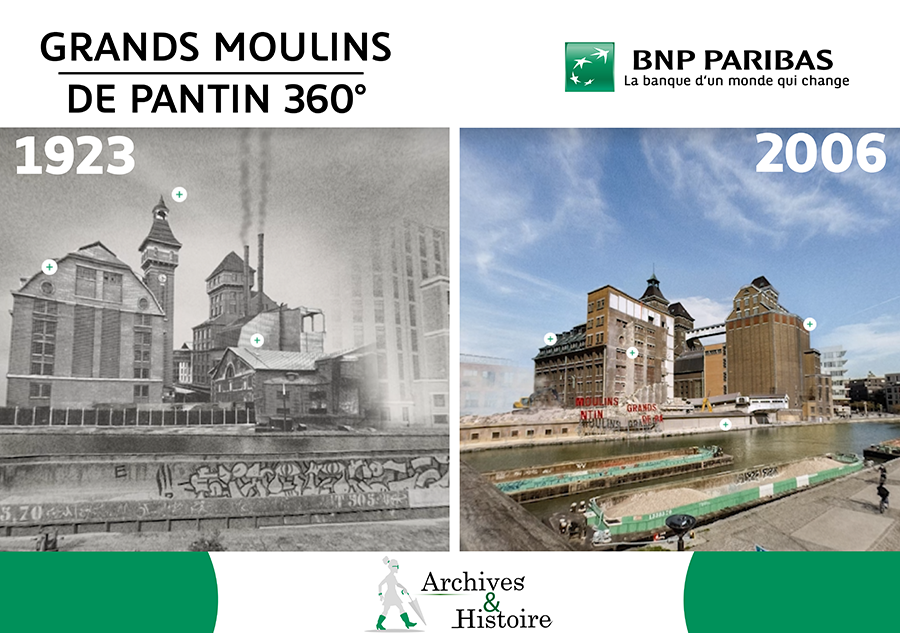
On 21 October 2009, after 3 years of work, the Grands Moulins de Pantin was inaugurated.
The move to the headquarters of BNP Paribas’ securities management and custody business reinforces the Group’s significant presence in Seine-Saint-Denis and its growing economic, cultural and social role, reflected in commitments such as Project Suburb.
To find out more about this industrial epic, leaf through the book
Grands Moulins de Pantin – L’usine et la ville, Evelyne Lohr, Geneviève Michel, Nicolas Pierrot, Denis Woronoff
Zoom-in the “Transbordeur” (ferry)
Originally designed in 1926, the footbridge was linked to the new warehouse to transport flour sacks to barges for top loading. Its overhanging section over the canal was abandoned with the installation of the tilting boom during the Second World War, but was put back into service in 1979 to ship bulk pellets for livestock. A pneumatic unloading/loading station for barges was also installed in 1939.
In the course of the Grands Moulins de Pantin, June 2022, BNP Paribas Historical Archives.




